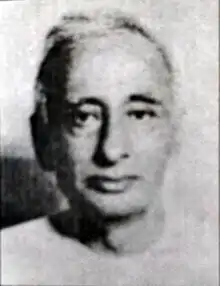
Ratnamanirao Bhimrao Jhote (19 October 1895 – 24 September 1955) was an Indian historian who wrote extensively on the history and culture of Gujarat.
Biography
Ratnamanirao Bhimrao Jhote was born on 19 October 1895 at Bhuj to Dewan Motilal Lalbhai. He was nicknamed Bhanabhai by his family. He was born prematurely. His maternal home was in Sankali Sheri in Khadia, Ahmedabad. During his childhood, he used to publish handwritten weekly Ghar Samachar for his home in which he used to write a title article, about family members, "missing" items and a Gujarati translation of an English novel. He started his primary education in English from Middle Highschool in Bhadra area. Later he joined R. C. Highschool where he completed his matriculation in 1914. He completed B. A. in Sanskrit and English from Gujarat College in 1919. He joined business firm dealing in cloth and cotton yarn.[1] He had close relationship with Sir Chinubhai Baronet and Anandshankar Dhruv.[2]
He received an attention when he wrote an article, Gujaratni Sanskriti Ane Itihasnu Vihangavlokan (Bird's View of Culture and History of Gujarat). Initially he wrote research articles in Kumar magazine. He did research on the Somnath temple when it was re-erected by Vallabhbhai Patel.[2]
He died after prolonged illness around 3:30 pm on 24 September 1955.[2]
Works
Apart from history and culture, he wrote plays, poems and on astrology.
History
- Amdavadno Parichay (Introduction of Ahmedabad)
- Khambhatno Itihas (History of Cambay; 1935)
- Gujaratno Sanskrutik Itihas (Cultural History of Gujarat)
- Gujaratnu Vahanvatu (Maritime History of Gujarat)
- Gujaratnu Patnagar Amdavad (Ahmedabad: Capital of Gujarat; 1929)[3][4][5]
- Gujaratno Sanskrutik Itihas Islam Yug (Cultural History of Gujarat: Islamic Era, Four Volumes)[6]
- Somnath (1949)
- Amdavadnun Sthapatya : Eno Itihas Ane Samanya Ruprekha (Architecture of Ahmedabad: Its History and Timeline; 1929)
Others
He translated The Admirable Crichton by J. M. Barrie as a Gujarati play Sambhavit Sundarlal (1940). It had two-three shows.[2]
Recognition
Jhote was awarded the Ranjitram Suvarna Chandrak in 1933.[2]
References
- ↑ Achyut Yagnik (2 February 2011). Ahmedabad: From Royal city to Megacity. Penguin Books Limited. p. 7. ISBN 978-81-8475-473-5. Archived from the original on 11 January 2022. Retrieved 31 October 2016.
- 1 2 3 4 5 Mehboob Desai (22 September 2015). "ઇતિહાસકાર રત્નમણિરાવ જોટેની અંતરંગ વાતો". Webgurjari (in Gujarati). Archived from the original on 24 October 2016. Retrieved 23 October 2016.
- ↑ Vashi, Ashish (1 October 2008). "Garba songs are slices of history". The Times of India. Archived from the original on 21 September 2016. Retrieved 23 October 2016.
- ↑ "Bapu had a dream for Amdavad". The Times of India. 17 April 2011. Archived from the original on 24 October 2016. Retrieved 23 October 2016.
- ↑ "Tides of the Sabarmati". Livemint. 4 March 2011. Archived from the original on 24 October 2016. Retrieved 23 October 2016.
- ↑ Mehboob Desai (14 July 2011). "આપણો સાંસ્કૃતિક વારસો છે મધ્યકાલીન અમદાવાદની મસ્જિદો". Divya Bhaskar (in Gujarati). Archived from the original on 24 October 2016. Retrieved 23 October 2016.